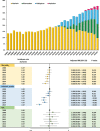2021 Focused Update Consensus Guidelines of the Asia Pacific Heart Rhythm Society on Stroke Prevention in Atrial Fibrillation: Executive Summary
- PMID: 34773920
- PMCID: PMC8763451
- DOI: 10.1055/s-0041-1739411
2021 Focused Update Consensus Guidelines of the Asia Pacific Heart Rhythm Society on Stroke Prevention in Atrial Fibrillation: Executive Summary
Abstract
The consensus of the Asia Pacific Heart Rhythm Society (APHRS) on stroke prevention in atrial fibrillation (AF) has been published in 2017 which provided useful clinical guidance for cardiologists, neurologists, geriatricians, and general practitioners in the Asia-Pacific region. In these years, many important new data regarding stroke prevention in AF were reported. The practice guidelines subcommittee members comprehensively reviewed updated information on stroke prevention in AF, and summarized them in this 2021 focused update of the 2017 consensus guidelines of the APHRS on stroke prevention in AF. We highlighted and focused on several issues, including the importance of the AF Better Care pathway, the advantages of non-vitamin K antagonist oral anticoagulants (NOACs) for Asians, the considerations of use of NOACs for Asian AF patients with single one stroke risk factor beyond gender, the role of lifestyle factors on stroke risk, the use of oral anticoagulants during the "coronavirus disease 2019" pandemic, etc. We fully realize that there are gaps, unaddressed questions, and many areas of uncertainty and debate in the current knowledge of AF, and the physician's decision remains the most important factor in the management of AF.
The Author(s). This is an open access article published by Thieme under the terms of the Creative Commons Attribution-NonDerivative-NonCommercial License, permitting copying and reproduction so long as the original work is given appropriate credit. Contents may not be used for commercial purposes, or adapted, remixed, transformed or built upon. (https://creativecommons.org/licenses/by-nc-nd/4.0/).
Conflict of interest statement
B.J.: Served as a speaker for Bayer, BMS/Pfizer, Medtronic, and Daiichi-Sankyo and received research funds from Samjin, Medtronic, and Abbott. No fees have been received directly or personally. Y.T.: Research grants from Medtronic Japan, Boston Scientific, Japan Lifeline, WIN International, Abbott and Biosense-Webster, and speaker honoraria from Abbott and Biosense-Webster. G.Y. H. L.: Consultant and speaker for BMS/Pfizer, Boehringer Ingelheim, and Daiichi-Sankyo. No fees are received personally. The other authors report no conflict of interest.
Figures















References
-
- Zhang J, Johnsen S P, Guo Y, Lip G YH. Epidemiology of atrial fibrillation: geographic/ecological risk factors, age, sex, genetics. Card Electrophysiol Clin. 2021;13(01):1–23. - PubMed
-
- Chao T F, Liu C J, Tuan T C. Lifetime risks, projected numbers, and adverse outcomes in Asian patients with atrial fibrillation: a report from the Taiwan nationwide AF cohort study. Chest. 2018;153(02):453–466. - PubMed
-
- Kim D, Yang P S, Jang E. 10-year nationwide trends of the incidence, prevalence, and adverse outcomes of non-valvular atrial fibrillation nationwide health insurance data covering the entire Korean population. Am Heart J. 2018;202:20–26. - PubMed
-
- Bai Y, Wang Y L, Shantsila A, Lip G YH. The global burden of atrial fibrillation and stroke: a systematic review of the clinical epidemiology of atrial fibrillation in Asia. Chest. 2017;152(04):810–820. - PubMed
-
- Chao T F, Chiang C E, Lin Y J. Evolving changes of the use of oral anticoagulants and outcomes in patients with newly diagnosed atrial fibrillation in Taiwan. Circulation. 2018;138(14):1485–1487. - PubMed

